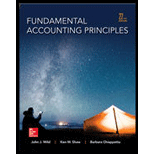
Concept explainers
Variance:
Variance is the difference between the actual cost and budgeted cost for particular level of activity. It is computed by deducting the budgeted cost from the actual cost of the production.
Direct Material Cost Variance:
The difference between the actual cost incurred on the direct material and the budgeted cost expected to be incurred is called the direct material cost variance. It can either calculated by deducting the budgeted cost from the actual cost or adding the direct material price variance and direct material quantity variance.
Direct Labor Cost Variance:
The variance between the actual labor cost incurred and the budgeted labor cost is termed as direct labor cost variance. It can be computed by deducting the budgeted labor cost from the actual cost. On the contrary, it can also be ascertained by adding the direct labor rate variance and direct labor efficiency variance.
Controllable Variance:
The overall variance which comprises of variable
Volume Variance:
The variance which arises due to difference in the budgeted level of activity and the actual level is called volume variance. The sole reason for this kind of variance is the variation in the level of activity.
To determine:
1. Computation of direct materials cost variance with its price and quantity variances.
2. Computation of direct labor cost variance with its rate and efficiency variances.
3. Computation of overhead controllable and volume variances.
Answer to Problem 4BPSB
Solution:
1. Kryll Company has unfavorable variance in direct material cost variance of $50,000 with unfavorable price variance of $250,000 and favorable quantity variance of $200,000.
2. Direct labor cost variance is $78,500 (F) with both favorable variance in rate of $62,500 and efficiency of $16,000.
3. The company has unfavorable variance of $136,000 in controllable variance and unfavorable variance of $252,000 in volume variance.
Explanation of Solution
1. Computation of direct materials cost variance with its price and quantity variances.
2. Computation of direct labor cost variance with its rate and efficiency variances.
3. Computation of overhead controllable and volume variances.
Conclusion:
The direct material price variance is $250,000 Unfavorable
The direct material quantity variance is $200,000 Favorable
The direct material cost variance is $50,00 Unfavorable
Want to see more full solutions like this?
Chapter 23 Solutions
Fundamental Accounting Principles -Hardcover
- No chatgpt 9. In a perpetual inventory system, what happens when goods are sold?A. Only sales revenue is recordedB. Inventory and cost of goods sold are updated immediatelyC. Inventory is updated at the end of the accounting periodD. Only cost of goods sold is recordedAnswer: Barrow_forward9. In a perpetual inventory system, what happens when goods are sold?A. Only sales revenue is recordedB. Inventory and cost of goods sold are updated immediatelyC. Inventory is updated at the end of the accounting periodD. Only cost of goods sold is recordedneed helparrow_forwardCan you demonstrate the accurate method for solving this financial accounting question?arrow_forward
- What effect does recording depreciation expense have on the accounting equation?A. Increases assets and increases equityB. Decreases assets and decreases equityC. Increases liabilities and decreases equityD. No effect on assets or equity No AIarrow_forwardNo ai 9. In a perpetual inventory system, what happens when goods are sold?A. Only sales revenue is recordedB. Inventory and cost of goods sold are updated immediatelyC. Inventory is updated at the end of the accounting periodD. Only cost of goods sold is recordedAnswer: Barrow_forwardSolve this question with accounting questionarrow_forward
- Hello tutor solve this situation with accounting questionarrow_forwardWhat effect does recording depreciation expense have on the accounting equation?A. Increases assets and increases equityB. Decreases assets and decreases equityC. Increases liabilities and decreases equityD. No effect on assets or equity helparrow_forwardWhat effect does recording depreciation expense have on the accounting equation?A. Increases assets and increases equityB. Decreases assets and decreases equityC. Increases liabilities and decreases equityD. No effect on assets or equityarrow_forward

 AccountingAccountingISBN:9781337272094Author:WARREN, Carl S., Reeve, James M., Duchac, Jonathan E.Publisher:Cengage Learning,
AccountingAccountingISBN:9781337272094Author:WARREN, Carl S., Reeve, James M., Duchac, Jonathan E.Publisher:Cengage Learning, Accounting Information SystemsAccountingISBN:9781337619202Author:Hall, James A.Publisher:Cengage Learning,
Accounting Information SystemsAccountingISBN:9781337619202Author:Hall, James A.Publisher:Cengage Learning, Horngren's Cost Accounting: A Managerial Emphasis...AccountingISBN:9780134475585Author:Srikant M. Datar, Madhav V. RajanPublisher:PEARSON
Horngren's Cost Accounting: A Managerial Emphasis...AccountingISBN:9780134475585Author:Srikant M. Datar, Madhav V. RajanPublisher:PEARSON Intermediate AccountingAccountingISBN:9781259722660Author:J. David Spiceland, Mark W. Nelson, Wayne M ThomasPublisher:McGraw-Hill Education
Intermediate AccountingAccountingISBN:9781259722660Author:J. David Spiceland, Mark W. Nelson, Wayne M ThomasPublisher:McGraw-Hill Education Financial and Managerial AccountingAccountingISBN:9781259726705Author:John J Wild, Ken W. Shaw, Barbara Chiappetta Fundamental Accounting PrinciplesPublisher:McGraw-Hill Education
Financial and Managerial AccountingAccountingISBN:9781259726705Author:John J Wild, Ken W. Shaw, Barbara Chiappetta Fundamental Accounting PrinciplesPublisher:McGraw-Hill Education





